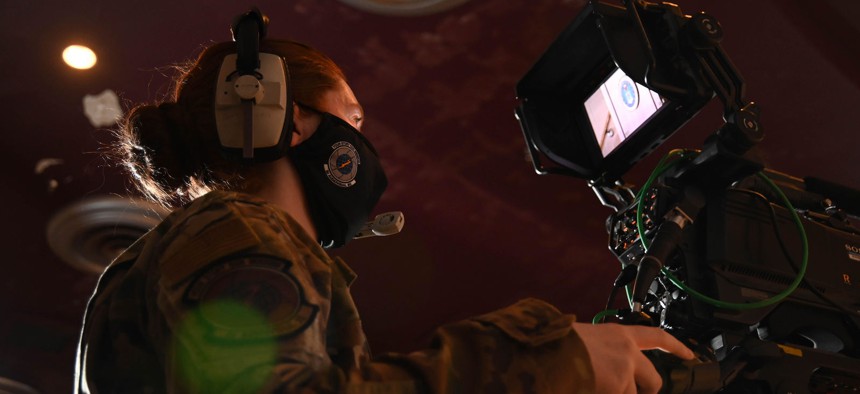
U.S. Air Force Staff Sgt. Jourdan Barrons, visual production specialist at the 2nd Audiovisual Squadron, angles her camera at the podium before show start at Hill Air Force Base on February 5, 2021. DOD
Space Force Has a Plan for Training Its Troops. Now It Must Figure Out What They Need to Learn
The newest service can’t train the same way its sisters do. It needs a new simulated environment.
Unlike its earthbound sister services, the Space Force can’t simply head out to some terrestrial exercise range to train its troops, develop new tactics, or peer into the future of weaponry. Nor do Space Force units have a natural deploy-and-rebuild cycle that affords time for advanced training. So the two-year-old service is creating a new force-generation concept and modeling and simulation environments, a top Space Force leader said.
“Whether it's missile warning or precision, navigation, timing, military satellite communications— all of that doesn't stop. None of it stops,” Lt. Gen. Chance Saltzman, the Space Force’s deputy chief of space operations, nuclear, and cyber, said Monday. “So how do I figure out how to organize and present the forces where it preserves some residual capacity to do the advanced training?”
The answer, Saltzman told a virtual audience at a Mitchell Institute for Aerospace Studies event, is a new force-generation model that uses rotations to create time for Guardians to be away from the immediate duties, which has become more practically achievable now that the Force has reached 8,400 active duty troops, as of August.
This model will also allow Guardians to get much-needed practice for the first war in space.
“Our human capital was not designed for a contested environment,” Saltzman said.
Indeed, what do Guardians need to be trained to do? Much of it has to do with protecting satellites, either from decades-old threats like electromagnetic interference or from newer weapons like lasers. You have to know what the satellite has on it and what the trade-offs are if you move it to dodge incoming fire, if you reposition it to a new orbit, or if it has some other defensive tool onboard.
“The ability to mitigate a directed energy threat, if you will, whether it's [radio frequency] energy, lasers, etc.—sometimes that's maneuver, sometimes that’s repositioning, and sometimes that’s subsystem operation on the satellite itself to try to mitigate those capabilities,” Saltzman said.
Military officials have revealed very little about the sorts of defensive and offensive capabilities they want to put on future spacecraft, aside from an ability to maneuver. That’s partly because they don’t yet know what tactics will be most effective given what they already have. There are, Saltzman said, “a number of tactics that we've currently developed and, I would project, there are a lot we have yet to develop. A lot of times what we do is we may have a good idea, but since we haven't tested it on any kind of range capability, we haven't tested against a thinking adversary, I'm not sure whether it would qualify as a tactic or a good idea at this point. And so as we build out the modeling and sim capability to really put our tactics to the test, then we'll be able to lean more on the operators to employ those tactics should they need to mitigate a threat.”
Once that training environment exists, Guardians can begin training for future space fights. That, in turn, will allow Space Force leaders to figure out what satellites need to survive space conflict.
That’s very similar to the way the Air Force figures out what new capabilties it needs, Saltzman said. The cycle starts with a threat assessment from the intelligence community, looking at how an adversary’s capabilities stack up against what the United States has deployed.
“Once those vulnerabilities are identified, the weapons and tactics community goes through a process where it determines: Are there tactics that we can employ that would mitigate or cover the gap?” he said. “For all the crews executing those weapons systems, periodically they'll discover that ‘hey, there are no tactics that can really counter this capability. What we need is a new piece of hardware or a new pod or a new receiver.’ Then the weapons and tactics process documents that shortfall in terms of some basic requirements. And then those requirements are fed back in through the acquisition community to start to develop the hardware or software solution that the operators need. And so it's that cycle that we in the Air Force called weapons and tactics, which informs the acquisition as well as the training community to prepare the operators.”
But the Space Force doesn’t have that process in place yet, in part because they need the training environment to test what tactics work and which ones need a new special hardware or software boost. “We don't really have that complete cycle accounted for because we don't have the advanced training requirements documented. So that's what I'm trying to do is then build that test and training infrastructure that allows them to validate and the range infrastructure that will provide those capabilities and that feedback through the loop,” he said.
NEXT STORY: DHS Reveals Next Research Interests




